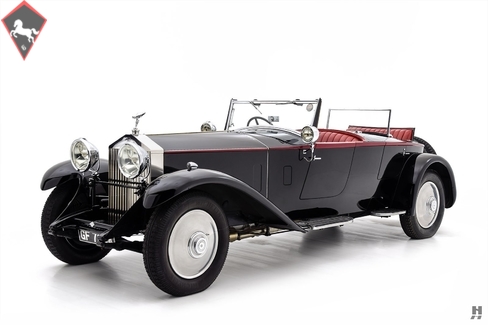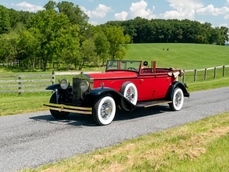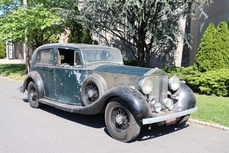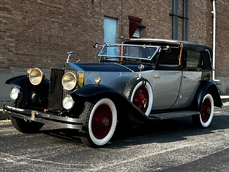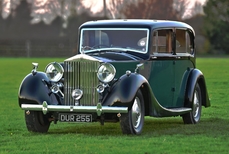Rolls-Royce Phantom II Two Seater Open Sports By Hooper 1930
General description :
Announced in 1929, the magnificent Phantom II served the role of Rolls-Royce’s flagship model for six years and set the standard for other manufacturers of luxury motorcars the world over. Central to the new car was a new 7,668cc six-cylinder engine that shared only the bore and stroke dimensions with the outgoing Phantom I unit. Key developments included a crossflow cylinder head, separate inlet ports, improved exhaust manifolds and a bump in compression that released an additional 20 horsepower. Rather than boast about output, Rolls-Royce’s marketing department allowed the unparalleled levels of refinement to speak for them. Paired with the marvelous engine was a new chassis and driveline afforded all around better handling, ride quality as well as a lower floor line - much to the delight of coachbuilders who could now fit lower and sleeker bodies at the behest of their clients. Sales of the Phantom II were quite respectable, with 1,545 examples built through 1935.
The great English coachbuilders of the time practiced their craft with the PII chassis, with some more successful and prolific than others. Among the most prestigious was Hooper, established in 1805. From 1833 on, the firm held a Royal Warrant to provide coaches for the Royal Family; an agreement which they sustained for over 110 years. In Hooper’s own words, their coachwork was reserved for “the Royal and the distinguished,” and their extensive portfolio of designs ranges from the sedate to the flamboyant.
Our featured Rolls-Royce Phantom II is a truly striking example, wearing one-off and distinctly sporting Two Seater Open Sports coachwork by Hooper. A well-documented example, chassis number 23GN has worn this evocative body from new, ordered by the noted English businessman, sportsman, and philanthropist Sir Julien Cahn. RROC records show he ordered this Phantom II on October 18, 1929. It arrived at Hooper at the end of February 1930, and the installation of the coachwork (Body Number 7351) was completed by April 1930. It was delivered to Sir Julian later that month, registered as GF7844. Cahn took over his family’s furnishing business and expanding aggressively, ultimately controlling more than 300 stores across England. His philanthropy led to his knighting in 1929, and he was made a baronet in 1934 for his charity work. He is best known for his keen interest and skill in fox hunting and especially in the sport of cricket, where he enjoyed a successful career as both a player and team owner.
Sir Julian's love of sport is reflected in his choice of coachwork for the Phantom II. While most Phantoms were clothed with elegant, formal bodies, this car is quite the opposite. The body is trim and clean, with a purposeful appearance befitting a wealthy sportsman. The design features a lovely boat tail treatment at the rear, abbreviated front wings, and step plates in lieu of full running boards. Bumpers were omitted from new, and dual rear-mounted spares lend a fabulous character, making the car appear even lower and longer than it already is. While officially designated a two-seater, the unique dual-cowl design can accommodate four passengers thanks to a discreet rear cockpit with a separate folding windscreen. When not in use, the seat and windshield fold to create a flat rear deck. Should inclement weather strike, unique individual hoods can be erected for both the front and rear compartments.
Sir Julien Cahn retained his beloved Phantom II until the outbreak of war when he dutifully donated it to The Ministry of War Transport. After the war, it was common practice to return cars to their original owners, but as Sir Julien passed away in 1944, the Rolls-Royce was sold to H.S.N Adams in 1946. R.D. Linford was the next owner, acquiring 23GN in 1957. In 1964, it was obtained by J.L. Mackinlay who was an active R.R.E.C. member and who regularly enjoyed the car for many years. In 1988, 23GN was still in England, owned by broker and colorful character Charles Howard. In 1991, Howard sold it to an American collector, Ken Behring. It remained in Behring’s collection through 1997 when it was sold to David Hogue, who then commissioned a comprehensive, professional restoration, adorning the car with the striking black and scarlet livery it wears today.
Following its magnificent restoration, the Phantom II debuted at the 1997 Pebble Beach Concours d’Elegance, where it received the coveted Lucius Beebe Memorial Trophy. It subsequently earned a CCCA Senior award in 2003 and was invited to return to the lawn at Pebble in 2018. This car appears in Lawrence Dalton’s Coachwork on Rolls Royce (p. 128), in Charles Howard’s “An AUTObiography (p.194) and in the December 2005 issues of Road & Track magazine which covered the inaugural 1,500-mile Pebble Beach Motoring Classic, a copy of which is included in the file.
Over the years, 23GN has been well maintained, with the restoration maturing slightly through regular use and enjoyment. The black paintwork is gorgeous, and the body finely detailed with period-correct accessories including Lucas King of the Road headlamps and spot lamps. Polished alloy wheel discs and black wall Michelin tires maintain the purposeful and sporty appearance. Front and rear cockpits are trimmed in matching red hides, with exquisite woodwork and restored original instruments adorning the dash. The rear compartment houses a set of factory PII tools. In addition, front and rear weather equipment and copies of the chassis card and build records will be included in the sale.
In approximately 2014, 23GN returned to England where Graham Moss of R.C. Moss performed a mechanical overhaul. In the interest of comfortable and reliable touring, a heavy duty Laycock P-Type overdrive unit mates with the original four-speed manual gearbox. The under-bonnet presentation is good. A unique and distinguished motorcar with documented provenance, this exciting Phantom II will be a welcome addition to the most discerning collections, sure to provide countless miles of motoring pleasure.
Offers welcomed and trades considered
https://hymanltd.com/vehicles/6331
1930 Rolls-Royce Phantom II Two Seater Open Sports By Hooper is listed sold on ClassicDigest in St. Louis by Mark Hyman for Not priced.
Car Facts
Car type : Car Make : Rolls-Royce Model : Phantom II Model Version : Two Seater Open Sports By Hooper Engine size : 0.0 Model Year : 1930 Location : Missouri
Sold
Seller Information
Sold
People who viewed this Rolls-Royce Phantom II also viewed similar Rolls-Royce listed at ClassicDigest
Other cars listed for sale by this dealer
About Rolls-Royce
Well, ladies and gentlemen, today we're diving into the illustrious history of a brand that has always embodied the very essence of British luxury and craftsmanship - Rolls-Royce.Our story begins at the turn of the 20th century when two visionaries, Charles Rolls and Henry Royce, decided to join forces. In 1904, the very first Rolls-Royce was born, the Rolls-Royce 10 hp. It was a modest start for a company that would go on to redefine automotive excellence.
But it wasn't until 1907 that Rolls-Royce truly made its mark with the introduction of the Silver Ghost. It was hailed as the "Best Car in the World" and set the gold standard for luxury motoring. With its whisper-quiet engine and exquisite craftsmanship, it was a statement of opulence and refinement.
The 1920s brought us the Rolls-Royce Phantom I, an icon of its time. It was the first Rolls-Royce to feature a 6-cylinder engine and set the stage for the legendary Phantom line. This was the era when the Maharajas of India commissioned custom-bodied Rolls-Royces that were nothing short of automotive palaces.
Fast forward to the post-war years, and we have the Silver Cloud, a symbol of post-war British optimism. The Silver Cloud was elegance personified, with its flowing lines and handcrafted interiors. It was the choice of royalty, celebrities, and captains of industry.
But if we're talking about the epitome of Rolls-Royce luxury, it's the Rolls-Royce Phantom VI, which graced us with its presence from 1968 to 1991. This was a car that made the statement that "if you have to ask the price, you can't afford it." Customization was the name of the game, and the Phantom VI was a canvas for the world's wealthiest to express their unique tastes.
Now, it's impossible to discuss Rolls-Royce without mentioning the Rolls-Royce Corniche. Produced from 1971 to 1995, it was a convertible and coupe version of the Silver Shadow. The Corniche was the quintessential grand tourer, a car for those who wished to traverse continents in absolute luxury.
But, alas, even the mightiest must face their decline, and Rolls-Royce was no exception. The company went through financial turmoil in the 1970s and 80s, leading to the takeover by Vickers plc. Then came the controversial BMW and Volkswagen ownership period, which divided enthusiasts.
Rolls-Royce regained its footing under BMW ownership, and the new millennium brought us the Rolls-Royce Phantom VII, a return to the company's roots of uncompromising luxury. The Phantom VII was a testament to British engineering and craftsmanship.
And that, ladies and gentlemen, brings us to today. Rolls-Royce continues to produce some of the most opulent, bespoke vehicles on the planet, a symbol of British imperiousness that has not waned with time. The spirit of Sir Henry Royce and Charles Rolls lives on in every car that bears the Spirit of Ecstasy, a testament to the enduring legacy of British automotive excellence.
